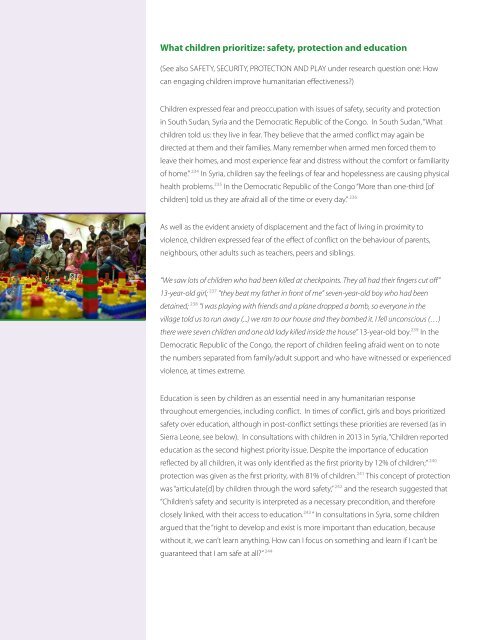putting-children-at-the-heart_full_text_final
putting-children-at-the-heart_full_text_final
putting-children-at-the-heart_full_text_final
- No tags were found...
Create successful ePaper yourself
Turn your PDF publications into a flip-book with our unique Google optimized e-Paper software.
Wh<strong>at</strong> <strong>children</strong> prioritize: safety, protection and educ<strong>at</strong>ion<br />
(See also SAFETY, SECURITY, PROTECTION AND PLAY under research question one: How<br />
can engaging <strong>children</strong> improve humanitarian effectiveness?)<br />
Children expressed fear and preoccup<strong>at</strong>ion with issues of safety, security and protection<br />
in South Sudan, Syria and <strong>the</strong> Democr<strong>at</strong>ic Republic of <strong>the</strong> Congo. In South Sudan, “Wh<strong>at</strong><br />
<strong>children</strong> told us: <strong>the</strong>y live in fear. They believe th<strong>at</strong> <strong>the</strong> armed conflict may again be<br />
directed <strong>at</strong> <strong>the</strong>m and <strong>the</strong>ir families. Many remember when armed men forced <strong>the</strong>m to<br />
leave <strong>the</strong>ir homes, and most experience fear and distress without <strong>the</strong> comfort or familiarity<br />
of home.” 234 In Syria, <strong>children</strong> say <strong>the</strong> feelings of fear and hopelessness are causing physical<br />
health problems. 235 In <strong>the</strong> Democr<strong>at</strong>ic Republic of <strong>the</strong> Congo “More than one-third [of<br />
<strong>children</strong>] told us <strong>the</strong>y are afraid all of <strong>the</strong> time or every day.” 236<br />
As well as <strong>the</strong> evident anxiety of displacement and <strong>the</strong> fact of living in proximity to<br />
violence, <strong>children</strong> expressed fear of <strong>the</strong> effect of conflict on <strong>the</strong> behaviour of parents,<br />
neighbours, o<strong>the</strong>r adults such as teachers, peers and siblings.<br />
“We saw lots of <strong>children</strong> who had been killed <strong>at</strong> checkpoints. They all had <strong>the</strong>ir fingers cut off”<br />
13-year-old girl; 237 “<strong>the</strong>y be<strong>at</strong> my f<strong>at</strong>her in front of me” seven-year-old boy who had been<br />
detained; 238 “I was playing with friends and a plane dropped a bomb, so everyone in <strong>the</strong><br />
village told us to run away (...) we ran to our house and <strong>the</strong>y bombed it. I fell unconscious (…)<br />
<strong>the</strong>re were seven <strong>children</strong> and one old lady killed inside <strong>the</strong> house” 13-year-old boy. 239 In <strong>the</strong><br />
Democr<strong>at</strong>ic Republic of <strong>the</strong> Congo, <strong>the</strong> report of <strong>children</strong> feeling afraid went on to note<br />
<strong>the</strong> numbers separ<strong>at</strong>ed from family/adult support and who have witnessed or experienced<br />
violence, <strong>at</strong> times extreme.<br />
Educ<strong>at</strong>ion is seen by <strong>children</strong> as an essential need in any humanitarian response<br />
throughout emergencies, including conflict. In times of conflict, girls and boys prioritized<br />
safety over educ<strong>at</strong>ion, although in post-conflict settings <strong>the</strong>se priorities are reversed (as in<br />
Sierra Leone, see below). In consult<strong>at</strong>ions with <strong>children</strong> in 2013 in Syria, “Children reported<br />
educ<strong>at</strong>ion as <strong>the</strong> second highest priority issue. Despite <strong>the</strong> importance of educ<strong>at</strong>ion<br />
reflected by all <strong>children</strong>, it was only identified as <strong>the</strong> first priority by 12% of <strong>children</strong>;” 240<br />
protection was given as <strong>the</strong> first priority, with 81% of <strong>children</strong>. 241 This concept of protection<br />
was “articul<strong>at</strong>e[d] by <strong>children</strong> through <strong>the</strong> word safety,” 242 and <strong>the</strong> research suggested th<strong>at</strong><br />
“Children’s safety and security is interpreted as a necessary precondition, and <strong>the</strong>refore<br />
closely linked, with <strong>the</strong>ir access to educ<strong>at</strong>ion. 243 ” In consult<strong>at</strong>ions in Syria, some <strong>children</strong><br />
argued th<strong>at</strong> <strong>the</strong> “right to develop and exist is more important than educ<strong>at</strong>ion, because<br />
without it, we can’t learn anything. How can I focus on something and learn if I can’t be<br />
guaranteed th<strong>at</strong> I am safe <strong>at</strong> all?” 244


